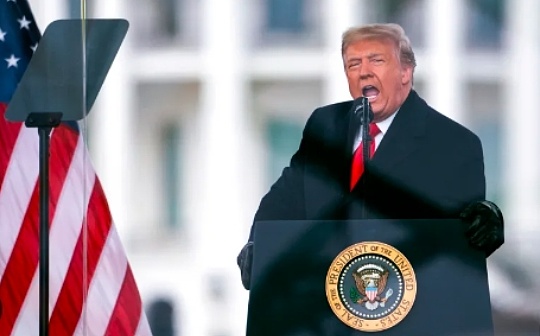
来源:中金点睛
Election situation: Trump is still leading, but his leadership is narrowing
特朗普在摇摆州依然保持领先。As of November 1, Trump still led the country’s polls, with a support rate of 48.4%, about 0.3 percentage points ahead of Harris.For comparison, during the 2016 and 2020 elections, Trump lagged 7.8 and 1.5 percentage points behind Hillary and Biden respectively.From the perspective of swing states, Trump maintained the lead, but narrowed slightly from a week ago, while Michigan and Wisconsin were overtaken by Harris.Referring to the current poll, if electoral votes are allocated exactly according to the current polls of each state, Trump and Harris will win 287 and 251 votes respectively (270 votes are the threshold for victory).
Chart: Trump maintains the lead, but narrows slightly from a week ago, while Michigan and Wisconsin are overtaken by Harris.

Judging from the faster-changing gambling market, Trump’s gambling odds advantage has narrowed significantly recently.According to RCP comprehensive data from various platforms, as of November 2, 2024, Trump and Harris’ gambling odds were 54.7% vs. 44.1%, a significant narrowing from 63.9% at the end of October.
Chart: Trump and Harris’ odds are 54.7% vs. 44.1%, a significant narrowing from 63.9% at the end of October
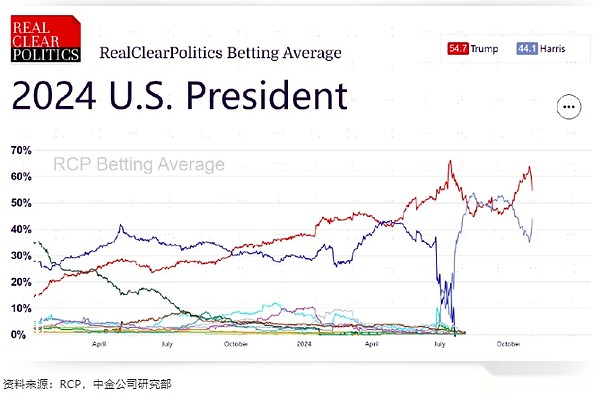
Early Voting: Democrats account for a high proportion, but the leading edge is not reliable based on partisan ownership.
The proportion of early voting and mail-in ballots is expected to still be as high as 65% this year.The United States has nearly 170 million registered voters, with a turnout rate of about 66% in the 2020 election (the number of votes accounts for the legal voting population), the highest level in more than a century.Based on the estimate of 245 million legal voters in 2024 and a 66% turnout rate in 2020, the total number of votes in 2024 may reach 160 million votes.As of November 1, early votes had 70 million votes (including on-site voting and mailing), accounting for 43% of the total votes. If mail-in ballots that have not been returned yet (but this part of the votes may not be completely returned),The number of early votes may reach 100 million, accounting for 65% of the estimated total votes.The proportion of early voting in the 2020 and 2016 elections was 64% and 36.6% respectively, and is still at a high level this year.
图表:2024年预估总票数是1.6亿票
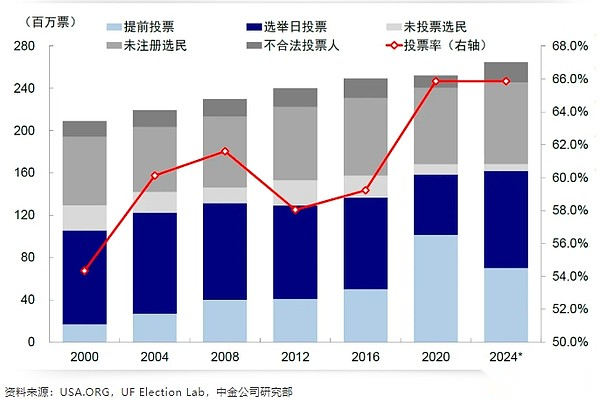
Chart: The estimated proportion of early voting is at a high level
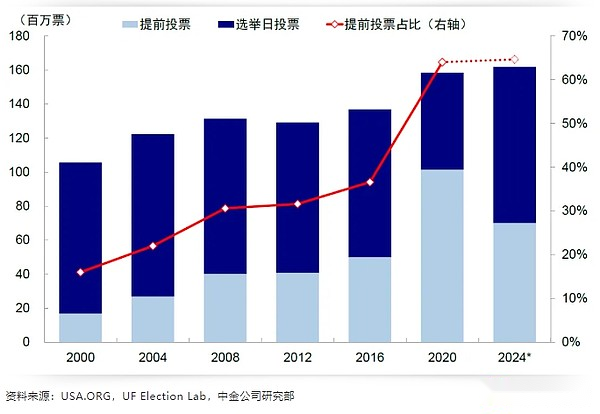
The proportion of registered Democratic Party members among voters in advance is higher than that of the Republican Party, but this is used as the final result with limited reference.Among the current 70 million early voting, according to UF Election Lab data, the proportion of members registered as Democratic and Republican parties is 38.2% and 36.1%, respectively, with little difference.CNBC data statistics are both 40%, which is also close.Among the votes that voted early, Democrats voted more by mail (42.6% vs. Republicans 33.5%), while Republicans accounted for a higher proportion of on-site votes (39.7% vs. Democrats 31.7%).However, in some swing states, especially Pennsylvania, which is the focus of this time, UF Election Lab estimates that Democratic members account for 56% of voters in advance, significantly higher than 33% of Republican members, and it seems that Harris has a more advantage.However, early voting does not mean early counting, and registered party members do not account for the vast majority of American voters. The proportion of early voting in the key swing state of Pennsylvania is not high (24%).Therefore, it is not reliable to judge the leading advantage based solely on the partisanship in early voting and early voting.
Chart: According to the party registration of early voters that have been accepted by swing states, Harris has a greater lead, but there is still great uncertainty in the election results.
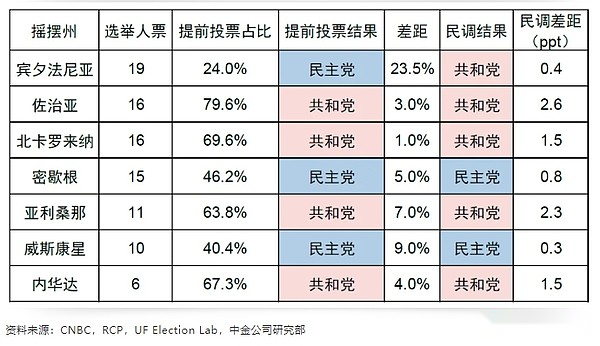
图表:各州提前投票党派
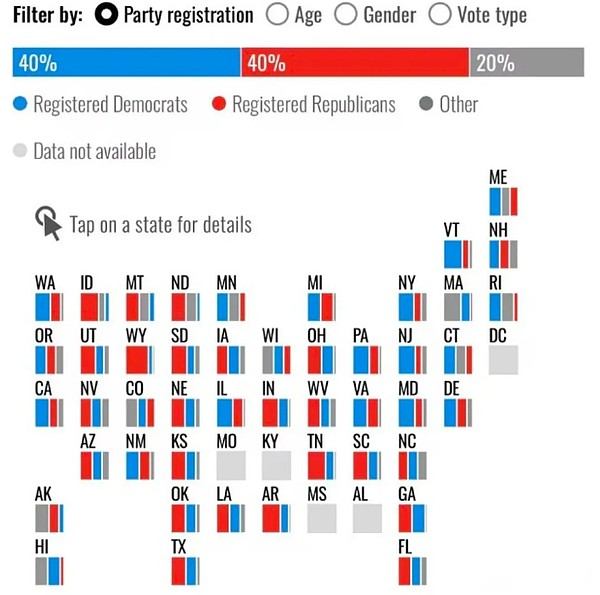
Watching guide: The main polling stations are basically closed at noon on the 6th, Beijing time, and the results may be released in the evening. Pennsylvania is the “race point”
As the voting day on November 5 approaches, how to track the real-time election situation of the general election and when the results will be obtained are all issues that everyone is very concerned about.
1.投票时间多久?Open from east to west according to the time zone, and it is basically closed at noon on the 6th Beijing time
Due to different time zones, polling stations in the United States have different opening and closing times on November 5, and are generally closed in sequence from east to west.For example, the first polling stations closed include parts of Indiana and Kentucky, with the closure time being at 6 pm Eastern Time on November 5 (corresponding to 6 AM Beijing time on the 6th).The last state to be closed is Alaska, from 12 noon to 1 pm Beijing time on the 6th.
七个重要摇摆州的投票截止时间为(The following are Beijing time): Georgia, 7:00 a.m. on the 6th; North Carolina, 7:30 a.m. on the 6th, Pennsylvania, 8:00 a.m. on the 6th, Michigan, 8:00 a.m. on the 6th, Arizona, 8:00 a.m. on the 6th, Arizona, 9 a.m. on the 6th, Wisconsin, 9 a.m. on the 6th, Nevada, 10 a.m. on the 6th.
Chart: The last swing state Nevada polling site closed at 10 a.m. Beijing time on the 6th
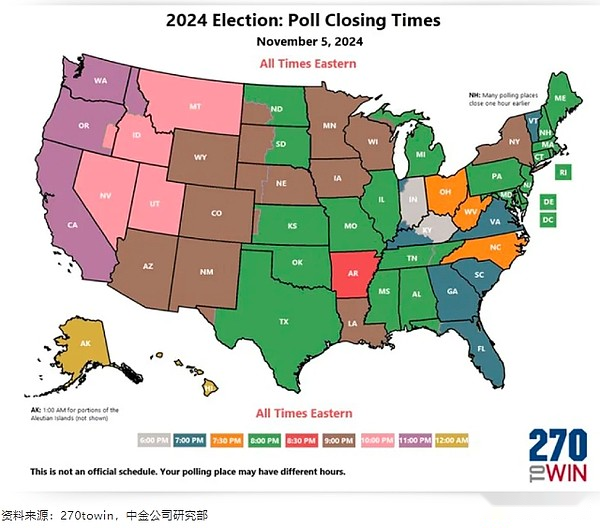
2.When will the results be released?Maybe on the evening of 6th Beijing time
The rules and time of counting votes vary from state to state. For example, some states vote while voting on the day of the voting day, while some states allow statistics to start early voting before the voting day.Shortly after the state polling stations were closed, a considerable number of voting results had been counted, and the remaining votes usually do not affect the overall situation unless the election situation is very close.Therefore, under normal circumstances, the final result will generally not be later than late at night on the voting day, that is, noon on the 6th Beijing time.However, if there are many mail-in ballots or trigger a recount, the result may be delayed.Judging from the rules that the majority of mail-in ballots account for and some swing states do not allow advance statistics, the final result may be slightly delayed, but it can be released basically in the afternoon or evening of Beijing time on the 6th.If the results of individual key swing states are very close and need to be recounted, it will also delay the results release time.Specifically for the 7 most critical swing states, the following are the specific counting time and details (all are Beijing time):
► Georgia: Or the swing state that first announced the results.Georgia has a higher proportion of early voting (80%), and has been processing mail-in ballots since October 21, requiring mail-in ballots to be sent before the polling stations are closed.90% of the vote count will be completed before 10:30 am on the 6th Beijing time.Georgia does not have a trigger mechanism for automatic recounting, but if the final gap is less than or equal to 0.5% of the total number of votes, candidates can apply for recounting.
► North Carolina: Results may be obtained at noon on the 6th.North Carolina also has a higher proportion of early voting (75%), and this year’s new regulations require mail-in ballots to be received before the voting day.Early voting and voting on Election Day will be respectivelyIt will be announced between 7:30 am and 9:30 am and 8:30 pm on the 6th Beijing time.North Carolina also does not have a trigger mechanism to automatically recount votes, but if the final gap is less than or equal to 0.5% of the total number of votes or 10,000 votes, the candidate can apply for a recount.
► Michigan: The results may be released at noon on the 6th.Most constituencies in Michigan start processing mail-in ballots on October 28, and mail-in ballots must be received before the polling stations on Election Day are closed.Most areas will complete the counting on the morning of the 6th, but the complete results will not be obtained in the evening.If the statewide vote gap is less than 2,000 votes, an automatic vote recount will be triggered.
► Pennsylvania: Or announced from the afternoon to the evening of the 6th.Mailed ballots must be received before the voting day. The processing starts at 7 a.m. on the voting day and is not allowed to count in advance, so the counting time may be relatively long.If the statewide vote gap is less than or equal to 0.5%, automatic vote counting will be triggered.
► Wisconsin: It may be announced from the afternoon to the evening of the 6th.Mailed ballots must be received before the voting day. As in Pennsylvania, early counting is not allowed, but this election staff must count votes all night to speed up the announcement.Historically, the counting was usually completed before 1 p.m.Wisconsin does not have a trigger mechanism to automatically recount votes, but if the final gap is less than or equal to 1%, the candidate can apply for a recount.
► Arizona: Preliminary results may be released in the morning, but all results are expected to be 5 p.m.Most voters vote by mail and are allowed to count early, but voting on Election Day requires waiting until the vote is over before counting.Preliminary results are usually released around 10 a.m., but there are two reasons for the extended overall announcement time: 1) The number of delivery on the election day needs to be calculated and announced before the official counting of votes, 2) Maricopa County, the largest county in the state, estimates that the electionThe complete statistics of the ballots cast at the polling station on the same day may not be announced until 5 pm.The trigger threshold for automatic recounting is 0.5%.
► Nevada: How many days does it take for mail-in ballot counting?The official voting results will be announced in a few hours, but it will take several days to count the mail-in ballots.Ballots must be stamped before the voting day, and mail-in ballots will start counting after they are received, but because Nevada allows ballots to be received by November 9, the counting time will be longer.
3.How to watch the battle?Pennsylvania is the “match point”, Harris “must” win over Pennsylvania, Trump’s winning paths are more
Due to the unique electoral vote mechanism of the United States and the stable “basic board” of both parties, most states play a role in “going through the motions” in the election. For example, according to the 270towin summary polls and predictions of different models, Harris BasicLock 226 votes, Trump locks 219 votes (270 electoral votes are required to win the election).
On the contrary, some so-called “swing states” whose positions are unclear and whose elections are stalemate have become the winners and losers of the general election.There are seven swing states in this election.Blue Wall State(Blue Wall, referring to states that have supported Democratic parties in the past eight presidential elections, but turned the tables in the 2016 election) includes Michigan (15, -0.8%, the former refers to electoral votes, and the latter refers to Trump’s poll leading Harry44 votes in total; Pennsylvania (19, 0.4%), Wisconsin (10, -0.3%);“Sunlight Belt”The southern swing states include Georgia (16, 2.6%), North Carolina (16, 1.5%), Arizona (11, 2.3%) and Nevada (6, 1.5%). A total of 49 votes.Among them, Pennsylvania has become the “match point” of this election because it has 19 electoral votes.
Judging from the current possibility and path of winning, Harris “must” win over Pennsylvania, otherwise it will be almost difficult to win. Pennsylvania is equally important to Trump, but there are other paths, at least one Blue Wall State (not necessarily).It’s Pennsylvania).The following are the specific paths:
► Trump’s winning path: Trump’s only winning the “Sunbelt” swing state is not enough to reach 270 votes, and he needs to win at least one blue wall state.1) If Trump wins Pennsylvania,Just get Georgia and Arizona in the Sunbelt (both Republican polls lead by more than 2%), and North Carolina or Nevada (1.5% of Republican polls lead by 1.5%) to win.2) If Trump loses Pennsylvania,Another more likely path is to win all the Sunbelt Four states as well as Wisconsin or Michigan, with Wisconsin Democrats taking a lower lead (0.3% lead).
► Harris’s path to winning: 1) If Harris wins all Blue Wall states, especially Pennsylvania, plus the current nearly locked traditional blue state votes reaching exactly 270, this is also the path to focus on its current campaign.Among these three blue wall states, Democrats have a slight lead in Michigan and Wisconsin polls, and Pennsylvania is particularly important.2) If Harris wins Pennsylvania but loses Michigan or Wisconsin,It is necessary to pay attention to whether North Carolina can reverse (the lead rate of Republicans in other states is lower).3) If Harris loses Pennsylvania, or loses Michigan and Wisconsin at the same time,It takes at least two swing states in the Sunbelt to win, which is very difficult.
Chart: Pennsylvania is the key, Harris’s challenge to lose Pennsylvania is significantly larger, Trump’s winning path is more
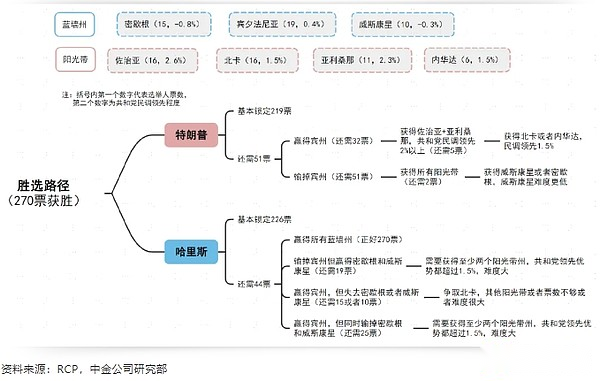
4.Possible accident?A draw or not admit the result
There are three possible draws in this election [1].In this case, the House and Senate need to vote together to elect the president and vice president, which may be more beneficial to the Republican Party, but will be extended.The three possibilities are: 1) Harris won Georgia, Arizona, Wisconsin, and Nevada; 2) Harris won Georgia, North Carolina, and Arizona; 3) Harris won North Carolina, Arizona, Wisconsin and Nevada.If the vote is equal, an emergency election will be held, the House of Representatives elected the president, and each state’s representatives form a delegation, and then voted in total. 26 votes and more won in the 50 states in the United States.The Senate elects the vice president, and each senator votes one vote, winning 51 votes and more.The elections in the House and Senate do not interfere with each other, and it is possible that the president and vice president are of different parties.By then, the ownership of the two houses of Congress in this election will play a key role.
The second accident is that the loser refuses to accept the election results.Generally, after the results are released, the loser will issue a statement to admit defeat and accept the election results.However, if the loser does not recognize the election results in a low-probability event, it may cause greater turmoil.For example, Trump once questioned the results in 2020, which triggered the Capitol Hill incident in early 2021.
Trading Guide: Overall “defying” has a greater chance of winning, but “Republicans win” requires more time
When thinking about the impact of election results on various assets, in addition to the effectiveness of the policy itself, we also need to consider the factors of expectations and policy rhythm:on the one hand,The market has already responded to Trump’s transactions in advance (such as US Treasury, US dollar, gold, traditional energy and financial stocks, Bitcoin, Mexico and Vietnam exchange rates, etc.), but the degree of different assets is included in different assets.The U.S. stocks, U.S. Treasury, US dollar, gold, Bitcoin and RMB exchange rates have relatively more expectations for Trump transactions, but the copper, crude oil and China’s export chains have relatively few expectations; on the other hand,The actual promotion of policies also takes time, and the order and difficulty of different policies vary.
Chart: Assets turn to Trump deal, but have been reprimanded recently
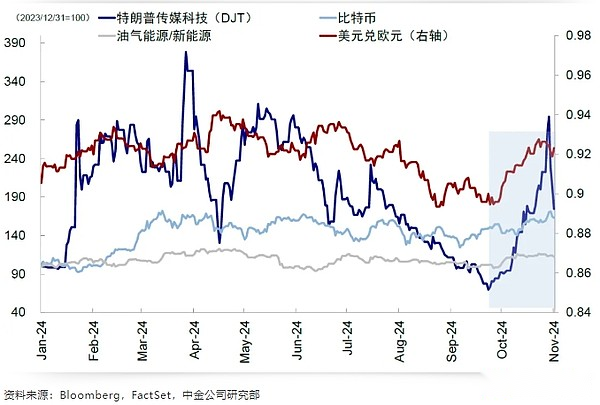
Chart: U.S. stocks, U.S. bonds, US dollar, gold, Bitcoin and RMB exchange rates account for relatively more Trump’s victory transactions, but copper, crude oil and Chinese export chain stocks account for relatively less
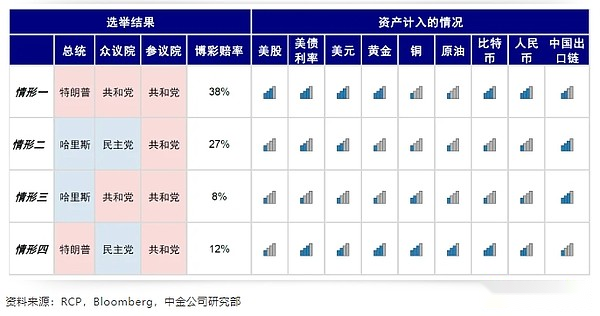
Based on this, the overall trading strategy we recommend is:1) If the results are stronger than expected,That is, “the Republican Party wins all” (President Trump + the Republican Party controls the Senate and the House of Representatives). Then the current “Trump deal” will have a period of upward rush, but it will then enter a period of waiting for policy.The actual reimbursement period is similar to the surge after the 2016 election and the gradual reimbursement after January 2017;2) If the results are lower than expected,That is, except for other situations where “Republicans win”, especially when Harris wins the election, it will directly lead to a direct reversal of all transactions.Specifically,
Chart: Experience in 2016: “Trump Transaction” → Postponement after policy is blocked → Restart after tax reform
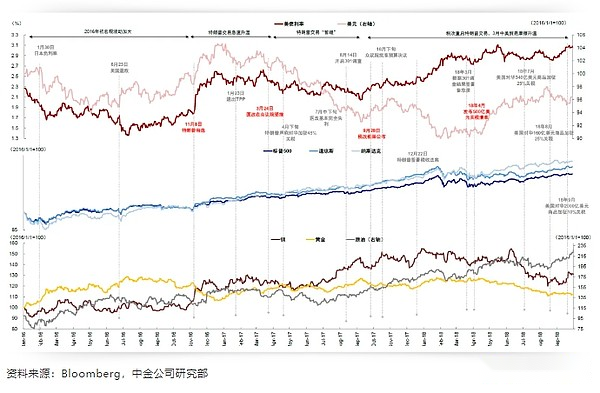
► “The Republican Party Wins All”It will strengthen the expectations of Trump’s policy advancement, forcing some investors who were hesitant to chase highs quickly.This means that there is still room for Trump’s transaction as a whole, and assets that were previously included in the smallest expectations will respond even more.1) US stocks, US bonds, US dollar and Bitcoin are still likely to rise in the short term.Similar to the Trump deal in 2016, the rebound will be lower than the previous round.After a period of time, it may be suspended or reversed.2) On the contrary,There is a risk that copper, crude oil and China’s export chains need to compensate for the insufficient inclusion of expected input.Strong cycle and resource-based risk assets such as copper and oil may rebound under reinflation expectations; based on uncertainty risk aversionGold may reverse; China’s export chain may be under marginal pressure, and industries with low exports to the United States and high imports to China may have relatively resilience.
► Other combinations except “Republican victory” may lead to a reversal of Trump’s trade.For example,Harris’ victory will directly lead to a reversal of Trump’s trade.For example, the interest rates of US dollar and US bonds, gold may pull back, and US stocks may even face certain pressure, while other assets damaged by Trump’s policy will be lifted.If Trump wins but Democrats control the House,The advancement of its incremental stimulus policies may be hindered, which will also reverse U.S. bond interest rates and the US dollar. U.S. stocks are also under pressure, but the export chain will still be under pressure, while gold will continue to trade tariffs and geopolitical uncertainties.
In summary, the overall “defying” trading idea has a greater chance of winning, but the “Republican Party wins” requires more time to let the bullets fly for a while.U.S. bonds provide trading opportunities after rising; gold pays attention to short-term overdraft risks, and can make partial profits when rising; U.S. stocks and the US dollar are active in the long term, but pays attention to short-term disturbances and waits for a better opportunity; export chains prevent risks; copper and oil are neutralMany, wait for the catalyst.
Chart: Asset impacts under different circumstances: Situation 1. Demand and inflation rise together; Situation 2. Three. Maintain the status quo; Situation 4 types of stagflation
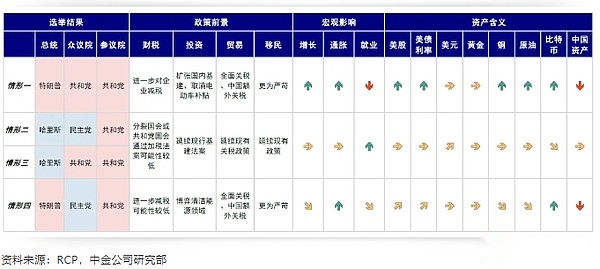
risk
The election situation remains variable, the poll data may have accuracy issues, and the speed and progress of policy introduction may not match market expectations.
[1]https://www.aljazeera.com/news/2024/10/31/route-to-270-how-trump-or-harris-would-win-the-us-election








